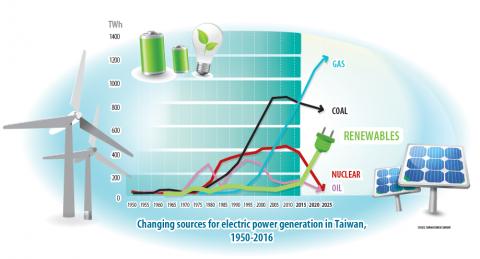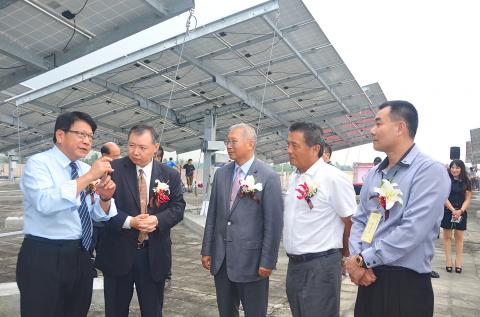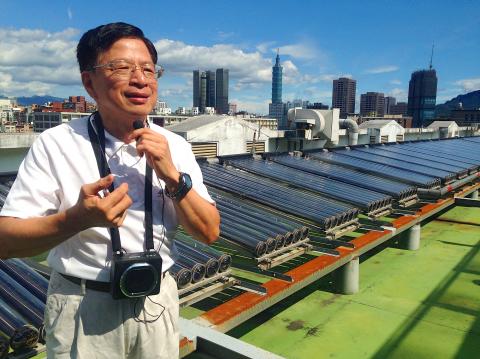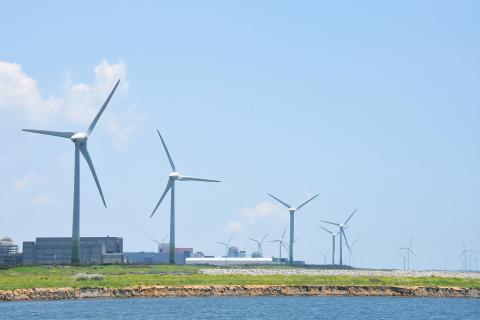Since the election of the Democratic Progressive Party (DPP) government led by President Tsai Ing-wen (蔡英文), the goal of an energy transformation has been pursued vigorously.
The arresting feature of Taiwan’s “green” shift is that it is part of a comprehensive industrial strategy that sees new industries and innovation as the driver of the next phase of development. The aim is to shift the industrial base away from it’s traditional reliance on contract manufacturing and focus instead on higher value-added service and “green” oriented business models.
FIVE PILLAR INDUSTRIES

Source: Taiwan Power Company
Tsai’s election campaign in late 2015 centered around the promotion of five “pillar industries” [to drive future growth] — the Internet of Things (also dubbed the Asian Silicon Valley), biotechnology, “green” energy, smart machinery and defense. Since taking office in January last year, the government’s strategy has morphed into the “five plus two” plan, encompassing the “new agricultural paradigm” and “circular economy” concepts. It has since broadened even further to include the “digital economy” and “cultural innovation” — but the name “five plus two” remains.
Taiwan is distinctive among industrial powers in its clear conception of linking “green” energy and wider economic goals with an industrial development strategy.
But problems in terms of “green” governance still exist. Complexities in approval processes mean that installing the new capacity for solar PV and wind power is time consuming. There are issues with implementing the medium-term solar and wind power goals, upgrading the grid to enhance stability and resilience as well as accommodating fluctuating power sources.

Photo: Yeh Yung-chien, Taipei Times
IN TRANSITION
The most significant element of the shift is the phasing out of nuclear power. Nuclear-powered electricity generation has been sharply reduced from 400 terawatt-hours (TWh) in 2015 to 300 TWh last year, and with no new starts allowed, further reductions are anticipated with the goal of reaching level zero by 2025.
Aside from phasing out nuclear power, the government has also pursued a strong commitment to raising the contribution of alternative energy sources (such as water, wind and sun) to electric power generation.

Photo: Weng Yu-huang, Taipei Times
In proportional terms, the contribution from these sources has risen from 4.8 percent in 2015 to 6.6 percent last year with a target of 20 percent by 2025. This is planned to come largely from the solar photovoltaic (PV) sector, expanded from a capacity of 1.3 gigawatts (GW) last year to 20 GW by 2025. Over the same period the capacity of wind power is to increase from 755 megawatts (MW) to 4,200 MW.
The level of coal is to be reduced from 45 percent to 30 percent of electricity generated by 2025, while gas is projected to peak at 50 percent in that same year.
The DPP government has an energy security policy commitment that focuses on natural gas as an interim bridging fuel while nuclear is wound back and alternative energy sources wound up — as is the case in Germany’s energy transformation program.

Photo: Yeh Yung-chien, Taipei Times
Data provided by Taiwan Power Co (Taipower) shows that the anticipated and probable generation levels in 2025, based on estimates of total generation of 2,400 TWh.
This is plausible if consumption growth is constrained by energy efficiency measures and direct solar PV generation expands.
Meanwhile, in a bid to promote innovation in the power sector, moves are underway to further liberalize the market by reducing the monopoly control of Taipower, with its legacy of nuclear power and fossil fuels.
Taiwan has also attracted support from foreign alternative energy source companies, notably the Danish giant Dong Energy — which last month renamed itself Orsted — has as partner in the new Formosa I wind farm project.
CHALLENGES
But concerns over the future of nuclear power in Taiwan remain. A major power outage in August, caused by malfunction of a gas supply valve in a gas-fueled power generator, prompted widespread debate, recriminations and calls for the restart of nuclear reactors.
Both the Minister for Economic Affairs Lee Chih-kung (李世光) and the Chairman of the gas supply company CPC Corp Chen Chin-te (陳金德) resigned taking symbolic responsibility for the disastrous incident.
While there is a strong popular green movement in Taiwan, the short-term economic constraint from increasing electricity prices and unstable grid service will require more advocacy from local citizens to make the goal of a “green” economy a feasible one.
Taiwan thus presents a fascinating case of the global energy revolution that is underway, where the commitment to move to a “green” power system is reinforced by a political shift. The government is strengthening this industrial strategy by building innovative industries for the future.

May 11 to May 18 The original Taichung Railway Station was long thought to have been completely razed. Opening on May 15, 1905, the one-story wooden structure soon outgrew its purpose and was replaced in 1917 by a grandiose, Western-style station. During construction on the third-generation station in 2017, workers discovered the service pit for the original station’s locomotive depot. A year later, a small wooden building on site was determined by historians to be the first stationmaster’s office, built around 1908. With these findings, the Taichung Railway Station Cultural Park now boasts that it has

The latest Formosa poll released at the end of last month shows confidence in President William Lai (賴清德) plunged 8.1 percent, while satisfaction with the Lai administration fared worse with a drop of 8.5 percent. Those lacking confidence in Lai jumped by 6 percent and dissatisfaction in his administration spiked up 6.7 percent. Confidence in Lai is still strong at 48.6 percent, compared to 43 percent lacking confidence — but this is his worst result overall since he took office. For the first time, dissatisfaction with his administration surpassed satisfaction, 47.3 to 47.1 percent. Though statistically a tie, for most

In February of this year the Taipei Times reported on the visit of Lienchiang County Commissioner Wang Chung-ming (王忠銘) of the Chinese Nationalist Party (KMT) and a delegation to a lantern festival in Fuzhou’s Mawei District in Fujian Province. “Today, Mawei and Matsu jointly marked the lantern festival,” Wang was quoted as saying, adding that both sides “being of one people,” is a cause for joy. Wang was passing around a common claim of officials of the People’s Republic of China (PRC) and the PRC’s allies and supporters in Taiwan — KMT and the Taiwan People’s Party — and elsewhere: Taiwan and

Six weeks before I embarked on a research mission in Kyoto, I was sitting alone at a bar counter in Melbourne. Next to me, a woman was bragging loudly to a friend: She, too, was heading to Kyoto, I quickly discerned. Except her trip was in four months. And she’d just pulled an all-nighter booking restaurant reservations. As I snooped on the conversation, I broke out in a sweat, panicking because I’d yet to secure a single table. Then I remembered: Eating well in Japan is absolutely not something to lose sleep over. It’s true that the best-known institutions book up faster